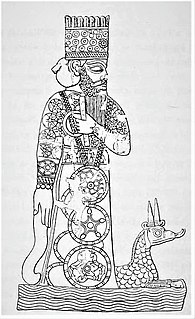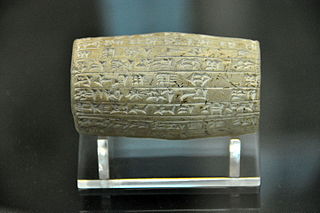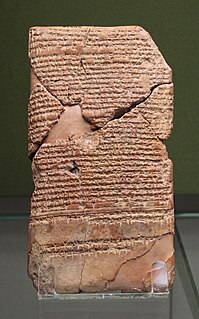
Etemenanki was a ziggurat dedicated to Marduk in the ancient city of Babylon. Originally 91 meters in height, it now exists only in ruins about 90 kilometres (56 mi) south of Baghdad.

Marduk was a late-generation god from ancient Mesopotamia and patron deity of the city of Babylon. When Babylon became the political center of the Euphrates valley in the time of Hammurabi, Marduk slowly started to rise to the position of the head of the Babylonian pantheon, a position he fully acquired by the second half of the second millennium BC. In the city of Babylon, Marduk was worshiped in the temple Esagila. Marduk is associated with the divine weapon Imhullu. His symbolic animal and servant, whom Marduk once vanquished, is the dragon Mušḫuššu. "Marduk" is the Babylonian form of his name.

Nabopolassar (; cuneiform: 𒀭𒀝𒌉𒍑𒌶dAG.IBILA.URU3Akkadian: Nabû-apla-uṣur; c. 658 BC – 605 BC) was a Chaldean king of Babylonia and a central figure in the fall of the Neo-Assyrian Empire. The death of Assyrian king Ashurbanipal in 631 BC resulted in political instability. In 626 BC, a native dynasty arose under Nabopolassar. He made Babylon his capital and ruled over Babylonia for a period of about twenty years (626–605 BC). He is credited with founding the Neo-Babylonian Empire. By 616 BC, Nabopolassar had united the entire area under his rule.

The Enûma Eliš is the Babylonian creation myth. It was recovered by English archaeologist Austen Henry Layard in 1849 in the ruined Library of Ashurbanipal at Nineveh. A form of the myth was first published by English Assyriologist George Smith in 1876; active research and further excavations led to near completion of the texts and improved translation.

The Ishtar Gate (Arabic: بوابة عشتار) was the eighth gate to the inner city of Babylon. It was constructed in about 575 BCE by order of King Nebuchadnezzar II on the north side of the city. It was part of a grand walled processional way leading into the city. The walls were finished in glazed bricks mostly in blue, with animals and deities in low relief at intervals, these also made up of bricks that are molded and colored differently.
The Hittites, also spelled Hethites, were a group of people mentioned in the Hebrew Bible. Under the names בני-חת and חתי they are described several times as living in or near Canaan between the time of Abraham and the time of Ezra after the return of the Jews from the Babylonian exile. Their ancestor was Heth.

The Alphabet of ben Sirach is an anonymous text of the Middle Ages inspired by the Hellenistic work known as the Sirach. Its date of authorship is estimated to have been anywhere between 700 and 1000 CE. It is a compilation of two lists of proverbs, 22 in Jewish Babylonian Aramaic and 22 in Mishnaic Hebrew, both arranged as alphabetic acrostics. Each proverb is followed by a Haggadic commentary. The work has been characterized as satire, and it contains references to masturbation, incest and flatulence. The text has been translated into Latin, Yiddish, Judaeo-Spanish, French and German. A partial English translation appeared in Stern and Mirsky (1998).

Amel-Marduk, 'man of Marduk' was the son and successor of Nebuchadnezzar II, king of Babylon.

Nebuchadnezzar I or Nebuchadrezzar I, r. c. 1125–1104 BC, was the fourth king of the Second Dynasty of Isin and Fourth Dynasty of Babylon. He ruled for 22 years according to the Babylonian King List C, and was the most prominent monarch of this dynasty. He is best known for his victory over Elam and the recovery of the cultic idol of Marduk.
Akitu or Akitum was a spring festival in ancient Mesopotamia.The Babylonian and Assyrian Akitu festival has played a pivotal role in the development of theories of religion, myth and ritual. While the purpose of the festival remains a point of contention among both historians of religion and Assyriologists, it is certain to have played a pivotal role in the regular setting of an agenda, priorities, and in the overall advancement of western civilization as being one of the first regularly occurring forums where proposals for social maintenance or change could consistently be made and crucial issues readily addressed.

The Neo-Babylonian Empire, also known as the Second Babylonian Empire and historically known as the Chaldean Empire, was the last of the great Mesopotamian empires to be ruled by monarchs native to Mesopotamia. Beginning with Nabopolassar's coronation as King of Babylon in 626 BC and being firmly established through the fall of the Neo-Assyrian Empire in 612 BC, the Neo-Babylonian Empire would be short-lived, being conquered after less than a century by the Persian Achaemenid Empire in 539 BC.

Psalm 9 is the ninth psalm of the Book of Psalms, generally known in English by its first verse, in the King James Version, "I will praise thee, O LORD, with my whole heart; I will shew forth all thy marvellous works." In Latin, it is known as "Domine Dominus noster". The topic of the psalm is that the success of evil is only temporary, and in the end, the righteous will endure. Psalm 10 is considered part of Psalm 9 in the Greek Septuagint and in most pre-Reformation Christian Bibles. These two consecutive psalms have the form of a single acrostic Hebrew poem.

The Cylinders of Nabonidus refers to cuneiform inscriptions of king Nabonidus of Babylonia. These inscriptions were made on clay cylinders. They include the Nabonidus Cylinder from Sippar, and the Nabonidus Cylinders from Ur, four in number.

Marduk-nādin-aḫḫē, inscribed mdAMAR.UTU-na-din-MU, ca. 1099 – 1082 BC, was the sixth king of the Second Dynasty of Isin and the 4th Dynasty of Babylon. He is best known for his restoration of the Eganunmaḫ in Ur and the famines and droughts that accompanied his reign.

Psalm 30 is the 30th psalm from the Book of Psalms. It is a psalm of thanksgiving, traditionally ascribed to David upon the occasion of the dedication of his house.

Psalm 21 is the 21st psalm from the Book of Psalms. It is internally accredited to David. There are 13 verses.

Psalm 31 is the 31st psalm of the Book of Psalms, generally known in English by its first verse, in the King James Version, "In thee, O LORD, do I put my trust". The Book of Psalms is the third section of the Hebrew Bible, and a book of the Christian Old Testament. In the Greek Septuagint version of the Bible, and in its Latin translation in the Vulgate, this psalm is Psalm 30 in a slightly different numbering system. In Latin, it is known as "In te Domine speravi". As indicated in the first verse in the Hebrew, it was composed by David.
Psalm 71 is the 71st psalm in the biblical Book of Psalms.

Kumayl bin Ziyad an-Nakha'i was among the most loyal companions of Imam Ali Ibn Abi Talib. Moreover, Kumayl occupies a prominent position in Shia Islam. Converting to Islam during the time of Islamic prophet Muhammad, he rose to a position of prominence during the caliphates of Uthman and Ali. In the caliphate of Ali, Kumayl flourished and served him in the most disciplined of ways. However, he is recognized for his pious and humble nature as well as preserving Imam Ali's teachings. Kumayl is best known for the du'a (supplication) of Prophet Khidr, which is commonly known by the name du'a Kumayl.

Agum II was possibly a Kassite ruler who may have become the 8th or more likely the 9th king of the third Babylonian dynasty sometime after Babylonia was defeated and sacked by the Hittite king Mursilis I in 1531 BC, establishing the Kassite Dynasty which was to last in Babylon until 1155 BC. A later tradition, the Marduk Prophecy, gives 24 years after a statue was taken, before it returned of its own accord to Babylon, suggesting a Kassite occupation beginning around 1507 BC.


















